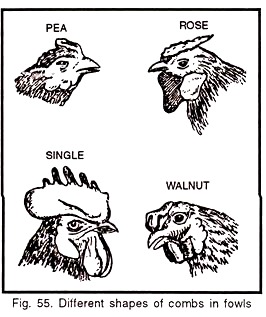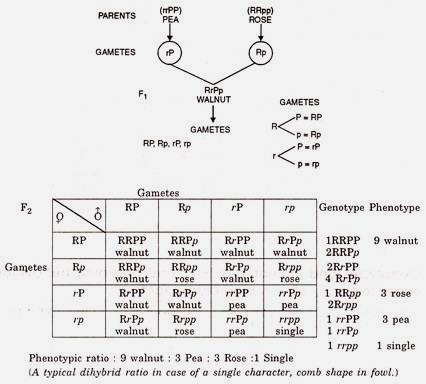ADVERTISEMENTS:
The following points highlight the eight important forms of gene expressions and interactions. The forms are: 1. Typical Di-Hybrid Ratio 2. Complementary 3. Supplementary 4. Polymerism 5. Epistatis 6. Inhibitory 7. Duplicate 8. Cumulative or Additive.
Form # 1. Typical Di-Hybrid Ratio (9:3:3:1):
This type of gene interaction produces the typical di-hybrid ratio of 9:3:3:1 in F2 for a single character. Evidently the concerned character is governed by two genes showing complete dominance.
In case of chickens or fowls, comb shape is governed by two genes. While one gene gives rise to rose comb, another gives rise to pea comb. Each of these two is dominant over single comb. However, when both are brought together, a new phenotype ‘walnut’ appears.
ADVERTISEMENTS:
As worked out by Bateson and Punnett, when both dominant alleles are present ‘walnut’ phenotype appears and when both recessive alleles are present ‘single’ comb appears. ‘Rose’ and ‘Pea’ phenotypes appear due to the presence of different single dominant alleles. If pea (rrPP) and rose (RRpp) are crossed, F1 birds showed ‘walnut’ comb as it has the dominant alleles of both the genes P and R.
Later on, when the F1 walnut combed birds were inbred together, in F2 generation there appeared walnut, rose, pea and single combed fowls. These types occurred in the proportions; 9/16 walnut, 3/16 rose, 3/16 pea and 1/16 single.
The mode of inheritance of the genes for ‘rose’ and ‘pea’ does not differ at all from the usual Mendelian scheme. The differences that distinguish this and similar cases from simple di-hybrid inheritance are that (i) the F1 does not resemble with parents and (ii) apparently new or unusual characters (walnut) results from an interaction between two independently inherited genes, and the other (single comb) results from the interaction of their two recessive alleles. These peculiarities are not due to a new method of inheritance but simply to the fact or circumstance that both genes involved happen to express themselves in this case (fowl comb).
Form # 2. Complementary Factor: The 9:7 Ratio:
In sweet pea (Lathyrus odoratus) two varieties of white flowering plants were seen. Each variety bred true and produced white flowers in successive generations. According to Bateson & Punnett, when two such white varieties of sweet pea were crossed, the offspring were found to have purple coloured flowers in F1 but in F2 generation 9 were purple and 7 white. This is again a modification of 9:3:3:1 ratio, where only one character i.e., flower colour is involved.
It is clear in the above example that for the production of the purple flower colour both complementary (C and P) genes are necessary to remain present. In the absence of either genes (C or P) the flowers are white.
Thus, it is clear that genes C and P interact and presence of both is essential for the purple colour in the flower. These types of genes in which one gene complements the action of the other gene, constitute complementary genes or factors.
(Complementation between two non-allelic genes (C and P) are essential for production of a particular or special phenotype i.e., complementary factor)
Genotypes and Phenotypes of F2 and breeding behaviour expected in F2 of complementary factors:
Aleurone colour in maize is also controlled by complementary genes.
Form # 3. Supplementary Factors (9:3:4):
ADVERTISEMENTS:
Here only one factor is sufficient to produce a phenotypic expression but addition of another factor causes the change in expression.
Or
Supplementary genes are two independent dominant genes interacting to produce a phenotypic expression different from that produced by either gene alone.
Or
ADVERTISEMENTS:
In supplementary gene action, the dominant allele of one gene is essential for the development of the concerned phenotype, while the other gene modifies the expression
of the first gene. For example, the development of grain colour in maize is governed by 2 dominant genes ‘R’ and ‘P’.
The dominant allele ‘R’ is essential for red colour production; homozygous state of the recessive allele ‘r’ (rr) checks the production of red colour. The gene ‘P’ is unable to produce any colour on its own but it modifies the colour produced by the gene ‘R’ from red to purple. The recessive allele ‘p’ has no effect on grain colour.
Showing genotypes and phenotypes of F2 behaviour of supplementary factors in grain colour of maize:
Examples of supplementary factors have also been seen in other plants and animals too. For instance, it is clearly visible in skin colour of house mouse and guinea pigs. When black mice are crossed with ordinary albinos, the progeny are usually all agouti like the wild type. When these F1 agouties are inbred, their progeny consist of 9/16 agouti, 3/16 black and 4/16 albino animals.
Form # 4. Polymerism (9:6:1):
When two genes govern any character separately, their effect is equal but when both the genes are present together, there phenotypic effect is increased or raised as if the effects of the two genes were additive or cummulative. It is notable in this case that both the genes show complete dominance.
“Additive or cummulative effect of genes present at different loci is called polymerism.”
In wheat three types of pericarp colour is found:
ADVERTISEMENTS:
(i) Deep red (ii) Light red and (iii) Colourless. When a cross is made between plants having deep red (AABB) and colourless (aabb) pericarp, the F1 (AaBb) has deep red pericarp due to the additive effect of both the genes A and B.
In F2 generation, on an average, 9/16 plants will have dominant alleles of both the genes A and B; as a result these plants will produce deep red per-carp. 6/16 plants will have light red pericarp since they have either A or B, but not both. The rest 1/16 plant will be homozygous recessive for both the genes and will be therefore, colourless.
Genotypes and phenotypes of the F2 generation:
Thus, polymerism interaction modifies the typical 9:3:3:1 ratio in to 9:6:1 ratio. Other examples of polymerism interaction are also known, e.g., fruit shape in summer squash etc.
Form # 5. Epistatic Factor or Epistatis (12:3:1):
The term “epistatis” was first of all used by Bateson (1909). It is the interaction between non allelic genes in which one gene suppresses the expression of other gene. A gene that hides or masks the expression of another non-allelic gene is called as epistatic factor and the gene that is hidden or suppressed is said to be hypostatic.
This phenomenon of masking one gene by another non-allelic gene is known as epistatis and is similar to dominance, except that it occurs between non-allelomorphic genes, instead of comprising allelomorphic genes. Such a gene interaction has been also named as masking gene action.
In Cucurbita pepo there are 3 types of fruit colour- (i) White (ii) Yellow and (iii) Green. White is found dominant over yellow as well as green colour. When yellow is crossed with green, yellow is found to be dominant. Here, the character (colour of fruit) is governed by 2 pair of genes-
White x green → White dominant
Yellow x green → Yellow dominant
Here white is dominant factor and yellow is hypostatic factor.
ADVERTISEMENTS:
White x Yellow → White dominant.
If white dominant is represented by ‘W’ and its recessive by ‘Y’, both non-allelic factors or genes may be represented as follows-
Form # 6. Inhibitory Factor (13:3):
In this type of modification two pairs of genes are involved and one of the non-allelic dominant gene inhibits the expression of the other non-allelic dominant gene.
Or
A gene which inhibits the expression of an active allele situated at different locus is called as inhibitory gene. Thus, in inhibitory gene action one dominant inhibitory gene prevents the expression of another dominant gene. Example of inhibitory gene is pigmentation in rice plants. In rice plants the presence of gene ‘P’ is responsible for deep purple leaves.
But if a gene ‘I’ is present then the expression of purple leaf colour is inhibited and the leaf becomes normal green. Thus in a cross, between green (IIpp) and purple (iiPP), all the offsprings in F1 are green but in F2 progeny, green and purple are obtained in ratio of 13:3. This modifies the typical 9:3:3:1 F2 ratio in to a 13:3 ratio.
It is now well understood that pigmentation in rice plant is governed by two non-allelic genes. ‘P’ gene produces purple colour while its recessive ‘p’ green colours. Another dominant gene ‘I’ which produces green colour in rice plants, inhibits or prevents the colour production by ‘P’ when both ‘I’ and ‘P’ are present together.
The recessive allels ‘I’ is ineffective and does not affect the colour production in any way in rice plants. Other examples of inhibitory gene action are the development of feather colour in fowls, seed colour in maize etc. Bateson and Punnett for the first time made the discovery of Inhibitory gene in fowls.
Genotypes and phenotypes of F2 generation:
Form # 7. Duplicate Factor (15:1):
The two pairs of factors which have identical effect are known as duplicate factors.
Or
Characters showing duplicate factor or gene action are governed by two dominant factors. These dominant factors produce the same phenotype whether they are alone or in pairs.
(Awned and awnless characters in rice plants)
Genotypes and phenotypes of F2 generation:
Thus in duplicate gene action, the presence of a single dominant allele of any one of two genes governing the dominant phenotype e.g., awned type in rice, while the recessive phenotype e.g., awnless is produced only when both the genes are in the homozygous recessive condition.
A similar case of duplicate factor interaction governs the fruit shape in Bursa, endosperm colour in maize, nodulation in groundnut and certain characters in many other plants. First of all, the duplicate gene interaction was observed and explained by G.H. Shull in plant called shepherd’s purse (Capsella bursapastoris.)
Form # 8. Cumulative or Additive Factors (1:4:6:4:1):
These are quantitative in nature. In this different degrees of phenotypes are brought about according to the number of doses of genes or factors present.
These differ from duplicate factors in respect that the phenotypic expression differs quantitatively in degrees according to the number of doses of the factors present in the offspring. The effect of these factors are cummulative or additive representing the effect of several factors acting together. Each gene contributes certain quantity of colour or weight or height or fertility.
The inheritance of a character like skin colour of Mulattoes appeared baffling or frustrating and even incompatible with gene theory. Davenport (1913) was the first man to explain the inheritance of skin colour in Mulattoes by the multiple factor hypothesis.
The human skin colour is due to presence of melanin pigments. He assumed that Negros of Africa differ from whites in 2 pairs of pigment producing genes showing no dominance. Negroes have four colour genes (P1P1P2P2) and whites have no colour genes (p1p1p2p2). The F1 generation of Mulattoes (P1p1P2p2) has 2 colour genes. Their colour is intermediate between the two parents.
The offsprings of Mulattoes with 2 colour genes will be:
6/16 Mulattoes with 2 colour genes
(Intermediate between the Negro & white parent)
4/16 Dark mulattoes with 3 colour genes (Intermediate between the original Negro and F1 mulattoes parent)
4/16 Light mulattoes with 1 colour gene
1/16 Black Negro with 4 colour genes resembling original Negro parent.
1/16 White with no colour gene ; gene resembling the original white parent.



















